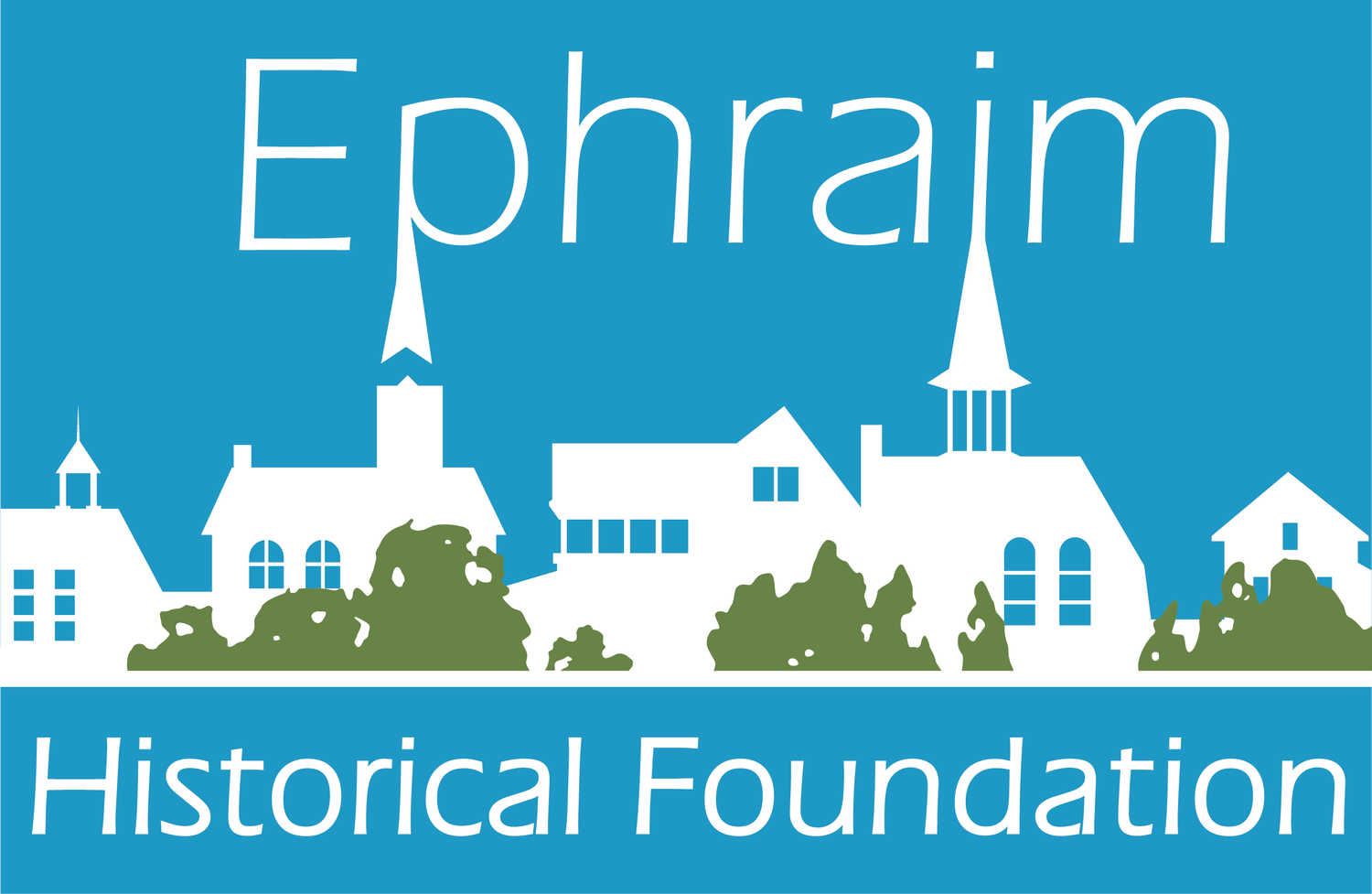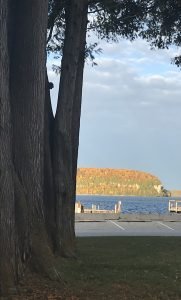Olga Dana Green: Breathing Space in a Bustling Landscape
Written in 2020 and revised in 2024
Olga Dana Green - Setting the Scene
Looking west from the intersection of Ephraim’s Cedar and Water (Hwy 42) streets, especially in summer, one can’t help but notice sailboats drifting peacefully in Eagle Harbor. In the foreground is a charming stone building designed by Russian-born architect Willam Bernhard. Built in 1926, it’s been an ice-cream parlor, restaurant, and even an art gallery. Today, it’s the Ephraim Information Center, the go-to place to find out what is happening in the village.
Standing there, one might hear the hum of traffic muffled by whooshing winds blowing off the bay. If one looks north or south, flocks of sightseers crisscross asphalt to be closer to the shore or to perhaps enter the Old Post Office Restaurant, one of the village’s fine eateries. It is located on the east side of Water Street, next to the Olga Dana Green. In 1871 the restaurant was a general store, later a barbershop, and for a time Ephraim’s actual post office.
View from Olga Dana Green
With so many interesting distractions, it’s easy to miss the patch of green space that is right across from the Ephraim Yacht Club. Yet it’s there, the Olga Dana Green. It’s been there for all to enjoy since 1973.
A Kewaunee Native Responds to “the Ephraim Idea”
Fifty years ago, on July 21, 1973, Kewaunee native Olga Bertha Haney Dana attended the Ephraim Historical Foundation’s (EHF) annual meeting. She found words spoken that day deeply moving. Dana quickly made arrangements to gift her Ephraim quarter-acre front yard, described as a “park-like property,” to EHF. She also amended her will so that the organization had the first option to buy her Ephraim summer cottage, appraised at the time for $26,800. (The Foundation later sold the cottage.) Within fifteen months, philanthropist Olga Dana passed away.
Who was Olga Dana? And what idea, articulated in 1973 by then EHF board member Oscar Boldt, affected her so deeply?
A Wisconsin Woman in Twentieth Century
Olga and her sister Ruth were daughters of Laura and John Haney, prominent Kewaunee citizens. Laura’s father, Olga’s grandfather, served as a state senator. Her father John, a farm boy, became a self-made businessman. He started by selling farm implements. In time, John Haney branched out and helped create the Kewaunee Manufacturing Company. He was among the first in the area to sell automobiles. John and Laura Haney were generous with their wealth, including supporting local parks. Their philanthropy was not lost on their daughter, Olga.
Olga Dana was born in Kewaunee on September 11, 1891. The shift from an agrarian economy to an industrial one was transforming America, including the understanding of women’s role in society. These social changes, along with the financial advantages she was born into, created opportunities only imagined in earlier times. Dana attended the UW-Madison (Gamma Phi Beta sorority) and later the Art Institute of Chicago. She traveled with her family to places like Cuba and California.
In 1917, she married Dana B. Dishmaker. He grew up just around the corner in a house as impressive as hers. Dishmaker was a twin. He graduated from Northwestern University and was practicing medicine in Kewaunee. When the U.S. joined the Allies during WWI, Dishmaker enlisted with the medical corps. Over time, he became a beloved family doctor in Kewaunee.
The newspaper article detailing the couple’s wedding at high noon on October 20th at the family home, reads like a script from Downton Abbey, Wisconsin style. The article describes the groom, Lieutenant Dishmaker, as a “good-natured, sturdy lad liked by all of his pals.” He had found his bliss with Olga, “a capable, fine, wholesome, sweet American girl.” The wedding altar was “banked on either side with bouquets of yellow chrysanthemums, and over the back of them hung a large American flag.” Flower girls and bridesmaids, dressed in pink “walked up to the altar while the orchestra rendered Mendelsohn’s wedding march.” Olga wore a gown of “white Georgette satin embroidered with seed pearls.“ She carried a “shower bouquet” of white roses and lilies-of-the-valley.
Twenty-five years later during WWII, Dr. Dana died suddenly of a heart attack. Two of their sons were serving in the military and the third was attending Lake Forest Academy in Illinois. Described as “an intensely magnetic personality loved by everyone in the community” the good doctor had at some point changed his last name from Dishmaker to Dana, as did Olga.
Dr. Dana’s passing likely left a gaping hole in Olga’s life. Their three sons were essentially grown men, beginning to make their own way in the world. Olga reimagined her life for the next thirty-one years as a single woman, a widow, with opportunity to influence her corner of the world through meaningful philanthropy. Upon her death in 1974, the Door County Advocate described Olga Dana as “a patroness of the arts and humanities.” In addition to her gift of property to the Foundation, her obituary (click and scroll to page 7 of Door County Advocate) listed the Peninsula Music Festival, the Los Angeles Epilepsy Society, and the Door County Library as memorials. Two of her sons preceded her in death.
The Ephraim Idea
On July 26, 1972, board member Oscar Boldt (1924-2020) wrote a letter to EHF president John Zimdars. Boldt summarized thoughts he had expressed earlier. Boldt wrote, “While none of this [letter] is in final form, it might better express the idea than my rather rambling remarks at the Board meeting.” Boldt was likely responding to the Ephraim land use study prepared by Dr. William Tishler (UW-Madison) and the Door County Planning Commission. The study generated much local discussion. For his part, Boldt was concerned that Ephraim “maintain the village atmosphere” in light of increasing development pressure. Preserving buildings like the Pioneer Schoolhouse and the Anderson Store were important “not only as historical reminders but because they are so situated as to influence other developments around them.” Boldt’s four-page letter called for strategic and orderly preservation.
In the context of the “pre-digital” 1970s, references to Boldt’s letter began to routinely appear in EHF Board minutes. Minutes allude to several ideas that didn’t work out or took a different turn. On-going discussion, with rather complex negotiations and legalities, prompted measurable action regarding the organization’s strategic plan. (Source: EHF Board minutes March 22, 1975)
Chick Peterson designed the Village of Values brochure. Marguerite Schumann wrote the text.
A Village of Values
By the 1974 Annual Meeting, held in the Pioneer Schoolhouse, the Foundation had embarked on a marketing campaign to secure preservation funds for the long haul. The slogan? Ephraim: A Village of Values. Artist Charles Peterson, who had become a year-round resident of Ephraim in 1971, contributed sketches for a glossy, silver brochure. Sparse, inky-blue drawings evoked authentic simplicity. Paper stock felt solid, implying a financially secure organization with a sure future.
Marguerite Schumann of Sturgeon Bay crafted the text. She had been the Director of Publicity and Publications at Lawrence College. Sub-headings informed readers of Ephraim’s natural beauty and heritage by separately describing spiritual, cultural, and historical features of the village. These separate sections culminated with a final section titled The Ephraim Idea. The Ephraim Idea listed Foundation values, for example, "A healthy but minimal business development, with an awareness that current constructive enterprises should prosper." A chummy tone requesting contributions closed the soft pitch.
In today’s sound-bite society, five panels of 10-pt, single spaced text probably wouldn’t catch three seconds of attention. Word choice regarding gender and indigenous people sounds outdated, too. But who can argue with lines like:
A preservation effort to safeguard a classic village such as Ephraim is not simply the action of a gallant band of traditionalists fighting against change: it is a carefully-reasoned opposition with a positive focus. It aims to maintain cultural and spiritual qualities that are becoming all too uncommon today, but are still found in Ephraim.
For those who care deeply about Ephraim’s future, and for those simply curious about how the Ephraim Historical Foundation has evolved, the brochure is fascinating. A half-century later, we benefit from the fruits of the 1974 campaign. The Olga Dana Green is one of them.
Request a digital or print copy of the brochure by emailing info@ephraim.org.



